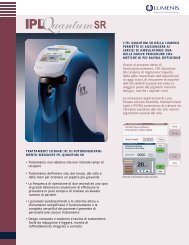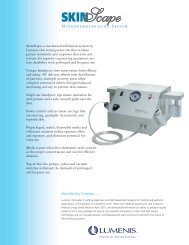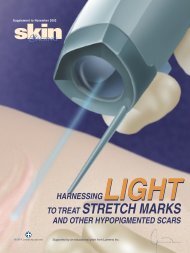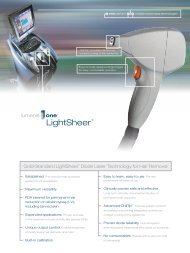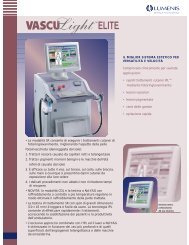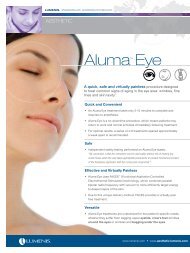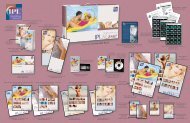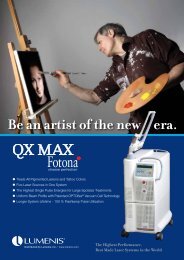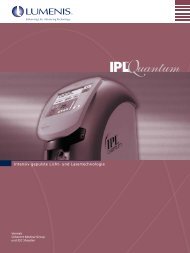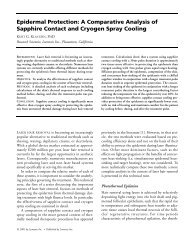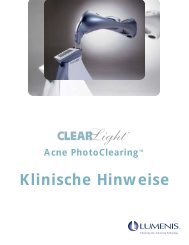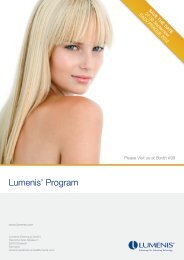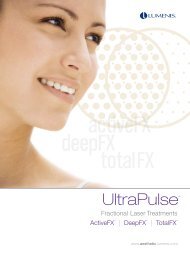Lumenis One - Birthmarks.com
Lumenis One - Birthmarks.com
Lumenis One - Birthmarks.com
Create successful ePaper yourself
Turn your PDF publications into a flip-book with our unique Google optimized e-Paper software.
4 LUMENIS ONE TM - AN EXPANDABLE TECHNOLOGY PLATFORM FOR COMPREHENSIVE AESTHETIC TREATMENTS JULY 2004<br />
IPL Skin Treatments Using Photorejuvenation<br />
Thirty six (36) patients with 49 treated areas were classified<br />
to this clinical application category. Full facial treatments<br />
were performed in 63% of the cases; neck, arms/hands and<br />
upper chest areas were also treated. The advantage of IPL<br />
skin treatments using Photorejuvenation is that they<br />
en<strong>com</strong>pass a wide range of conditions, including rosacea,<br />
erythema of rosacea, telangiectases, poikiloderma,<br />
melasma, hyperpigmentation, and various sun/age spots.<br />
Indeed, this array of conditions was represented in the<br />
evaluation, sometimes a <strong>com</strong>bination of conditions existing<br />
in the same patient or in the same treated area.<br />
Figure 3. IPL treatment of pigmented lesions – improvement level<br />
distribution per visit<br />
IPL Treatment of Pigmented Lesions<br />
Figure 2. IPL skin treatments using Photorejuvenation – improvement<br />
level distribution per visit<br />
Significant improvement was seen following two treatment<br />
sessions and continued to increase over the treatment<br />
course (see Figure 2). After three treatment sessions, all<br />
treated areas showed some level of improvement; after four<br />
treatments, 50-100% improvement was recorded for 83%<br />
of the treated areas. This improvement level was<br />
maintained and even enhanced, reaching 93% at the<br />
1-month follow-up.<br />
These results are also reflected in the satisfaction levels.<br />
In fact, after only two treatments, some satisfaction was<br />
reported for all treated areas, with a gradual increase of the<br />
satisfaction level to 86% ‘Very satisfied’ to ‘Extremely<br />
satisfied’ at the 1-month follow-up.<br />
Thirty five (35) patients with 40 treated areas were enrolled<br />
to this category. The majority (78%) of the lesions were<br />
lentigines, 13% were cases of hyperpigmentation (postinflammatory),<br />
and the rest were Café-au-lait spots,<br />
Becker’s nevus and age spots. Seventy percent (70%) of the<br />
treated pigmented lesions were located on the face or<br />
arm/hand areas; the rest were distributed among different<br />
sub-areas of the torso and legs.<br />
The recorded improvement levels for the treated pigmented<br />
lesions were statistically significant and very high. In fact,<br />
none of the areas remained unchanged following three<br />
treatments (see Figure 3). The percentage of pigmented<br />
lesions that reached 50-100% improvement after four and<br />
five treatment sessions was 95% and 100%, respectively.<br />
M o r e o v e r, five pigmented lesions (14%) cleared<br />
<strong>com</strong>pletely following only a single treatment session;<br />
an additional group of six treated areas (19%) reached<br />
<strong>com</strong>plete clearance after two treatments.<br />
In correlation to the investigator’s improvement<br />
assessments, the patient satisfaction levels were also very<br />
high, with some level of satisfaction being recorded for all<br />
treated areas at the 4th treatment session. By the 1-month<br />
follow-up, the satisfaction level rose to 100% ‘Very<br />
satisfied’ to ‘Extremely satisfied’.



